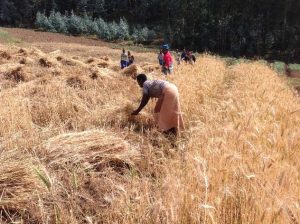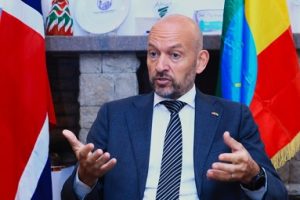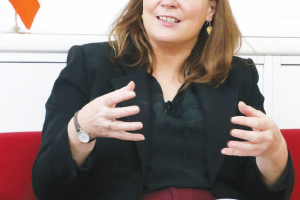
The Platform for Agricultural Risk Management is a system of the International Fund for Agricultural Development (IFAD) in Rome, Italy. The Ethiopian government reiterated its commitment to work with PARM on ARM in Horizon 2, focusing on sustainability and progressive ownership and building on the successful achievements of PARM operations in Horizon 1 (2014-2019).
On 7 May 2020, a virtual consultation was held between members of the Steering Committee of the Ethiopian Agricultural Extension Mandate Zonation and the PARM Secretariat.
Following the consultation, the Government nominated a Focal Point for a smooth implementation of the PARM Country process. PARM also appointed a Country Liaison Officer and a Country Lead Learning Facilitator to represent and facilitate the implementation of the PARM learning cycles and related activities in Ethiopia.
The PARM Horizon 2 activities in Ethiopia are built on the risk assessment studies implemented in 2015-2016 as part of the activities of PARM Horizon 1. The study was conducted by the Natural Resources Institute (NRI) of the University of Greenwich in collaboration with local experts.
Findings of the study was disseminated in a National Stakeholder Workshop held in Addis Ababa on the 16-17 December 2015 where stakeholders identified priority risks and the potential ARM tools. Comments from stakeholders were integrated into the final report, which was later published in December 2016 after the official validation from the Government partners.
Over the summer of 2021, in the context of PARM Horizon 2, PARM has mobilized technical resources including international and national experts to carry out the project design process in close collaboration with the Ministry of Agriculture (MoA) and the Extension Directorate.
PARM has finalized the design of capacity development (CD) program entitled Facility on Capacity Development for Agricultural Risk Management (CD4ARM) with a high level political ownership and appropriation. While developing the investment program, PARM initiated a resource mobilization drive to advocate and mobilize resource to invest in the facility.
During Horizon 1, PARM’s experience in Ethiopia included a three-day capacity development activity jointly organized in May-June 2018 in collaboration with Hawassa University and the MoA. The learning activity provided support on ARM training needs to the extension service in Ethiopia and possible opportunity for integration of ARM into undergraduate and graduate courses in the universities.
As PARM and the Ministry of Agriculture continued their collaboration, during Horizon 2, two blended (physical and virtual) learning cycles have successfully been implemented.
The first learning cycle consisted of six sessions spread over 10 days in May 2021, targeting 12 potential ARM resource persons in Afar, Amhara and Oromia regions. These sessions were followed by the organization of the Regional Learning Events in the same regions.
Over 100 trainees from the three regions with different academic and professional backgrounds benefited from contextualized training on the concepts and fundamentals of agricultural risk management.
The second learning cycle was held in July 2021, over a two-week span with 4 sessions. It targeted the learning of facilitators and the regional resource persons and provided them with more in-depth training on the key steps of the ARM cycle, especially on how to conduct agriculture risk assessments. The end goal of the learning cycles, as also agreed with the Ministry of Agriculture, was to collect information through a participatory approach to design the investment plan in the country.
On 28 October 2021, PARM has organized a co-vision and co-creation workshop, to gather recommendations and lessons learned from over 40 key partners working on ARM in Ethiopia to inform the project design process and integrate them into the project design report.
This was followed the next day, by an in-depth technical workshop with the MoA and other key players in ARM in the country to discuss the most recent project components proposed, to validate the key elements and direction of the project to be included, ensuring high ownership by the national partners.
Based on their comments, the design team drafted an Aide-Mémoire which recapitulated the key elements of the mission and the project, and was signed by the State Minister in charge of Agriculture and Horticulture.
Today’s Herald Guest is Anais Petijean, Community Practice and Digital Media Analyst with PARM. She works as the Community of practice Analyst at the Platform for Agricultural Risk Management (PARM) which is hosted by the International Fund for Agricultural Development in Rome.
During her brief stay with The Ethiopian Herald, she had explained the major risks facing the production and value chain in agriculture and how PARM helps in addressing them. Have a nice read!
Could you tell us about IFAD and its works of agricultural risk management in Ethiopia?
We started our work in Ethiopia in 2014. And we started for the Horizon 1 and now we have reached Horizon 2 in Ethiopia. We provide technical support to the government. And when we launch the process in a country in that case in Ethiopia, we always liaise with the Ministry of Agriculture of the country and we try to understand what the need of the country is and what the government wants us to do as PARM. Then we sign a memorandum and which states all the priorities of what PARM should do in the country and we always start with a risk assessment study, in order to identify the main risks in the agricultural sector of the country. And we try to use this risk and then identify the tools to manage this risk in a smart way. And then once we do that, we have capacity development and Knowledge Management Workshop where we invite different actors along the interesting value chain in the country.
The actors are like the private sector micro Finance, educational facility training centers and also small holder Farmers to follow our Workshop where we try to sensitize about what is a risk, how to manage risks, why it’s important to manage risk and what are the tools to do so. And once that is done, we develop a project; an investment project with the government as well and especially in Ethiopia. We developed the facility for capacity development for agricultural risk management, which both the goal of the project is really to empower our small holder farmers and pastoralists always keeping in mind the inclusion of women and youth and Empower them to identify and prioritize in the early spring the risk, the management of risk and using the tools to do so. And for Ethiopia, the project that I mentioned has identified 24 Kebeles to be targeted in the different areas of Amhara, Tigray and Afar regions. It includes 1, 800 households.
This project has different components and that here for example, we want to have a zonal and agricultural management profiling and Juice then we want to empower the capacity development and the last one is about arm coordination and Knowledge Management and all of this. The idea then now we are on a resource mobilization step. So, we encourage anyone who wants to partner with and to join us, because, our work is to target this small scale farmers in the end they can build their resilience so that they can keep on producing, their food.
Has PARM done so far any assessment of risks in farms here in Ethiopia? What did you observe?

There are several studies. We did not do the risk assessment in Ethiopia. We did the classical one and there is no problem here as we have developed a new methodology based on value chain. So, for example in Madagascar, we Identify together with the government the two main value chains, they want to focus on maize and peanuts and the idea of this new approach is really to take the main value chain and to understand along that valuation from beginning to end. What are the risks that could raise the value chain in order to anticipate everything and to have a smart way of managing it? So yeah, that that’s where the position part, where we engage in the project. We did not focus only on production.
What does it mean when you say risks can be changed into opportunity?
The risks are always there. It’s not like there is I’m going to, we’re going to face many more risk now even because of climate change because of the lack of access to finance, by the small holder farmers because of the gender gap. So the risks are here. So it’s not like we can avoid them. The importance is to acknowledge this risk and to make sure that we manage them in a way that we can anticipate, we can cope with the risk. And yes, it’s like something that it’s not always going to be here. But if we understand them if we understand the risk and how to manage it, then I guess these risks can turn into opportunity.
What are the major risks observed?
One of the major risks is the low accessibility of knowledge of some people living in remote areas. Maybe they have lack of knowledge in terms of Legal advice that they have in terms of digital access as well. Maybe they don’t have access to some application where they can know when it’s going to rain or not. These is kind of I think the digital Gap. The gender gap, of course women in terms of access to land, women are still behind, the social norms also, are refraining women to have access to land into agriculture, also the instability of the political situation in some countries and of course climate change. It’s impacted. Of course, I think if we don’t act now it might get worse. That’s for sure something in the future that we need to assess now.
In addition, you mentioned that with part numbers that are going to work with like, micro finance operatives and these kinds of organizations or institutions that already exist in Ethiopia. They will discharge their role and what kind of role do you expect from them?
And now we have developed this project which has set the budget of 12 million US dollars. We try to have people on board with us so that they can support the funding of this project.
What’s your observation of the agricultural risks affecting farmers and their value chain?
I guess in terms of security situation as well as climate change, drought and these kinds of things for sure . These are some of the main ways that you face in terms of food security here in Ethiopia.
Can you tell us what the end objective and your success rate? How long do you think for Ethiopia is part of our reason?
As I said, they trust that your government trusted them from Horizon 1 and they reiterated their trust in the pawn for Horizon 2. But now, we would really want to find for me for the PARM project so that PARM can support the implementation but kind of leave the project on the end of Ethiopia so that it’s a long lasting impact.
Thank you very much.
Thank you.
BY ZEKARIAS WOLDEMARIAM
THE ETHIOPIAN HERALD SATURDAY 13 JULY 2024





